 Php 11,103 needed to stay out of poverty
Php 11,103 needed to stay out of poverty
For the first half of 2021, a family of five in Davao Region needed at least Php 11,103 to be able to meet both basic food and non-food needs in a month. This is an increase of 4.8 percent from the poverty threshold posted in the same period in 2018, which was estimated at Php 10,598. At the national level, the monthly threshold was around at Php 12,082, on the average, which is 979 pesos higher than the region’s estimated threshold.
The poverty incidence among Davaoeño families during the first semester of 2021 was estimated at 14.0 percent. This means that about 140 out of 1,000 families had income below the amount needed to buy their basic food and non-food needs. The latest poverty incidence decreased from the estimated 17.8 percent during the same time in 2018. Moreover, the 14 percent poverty incidence among families translates to a magnitude of 195 thousand poor Davaoeño families, as compared from the same time in 2018 at 233 thousand poor families (see Table 1).
At the national level, the magnitude of poor families was estimated at around 4.74 million in 2021. This means that around 4.1 percent of the total poor families in the country in 2021 were in Davao Region.
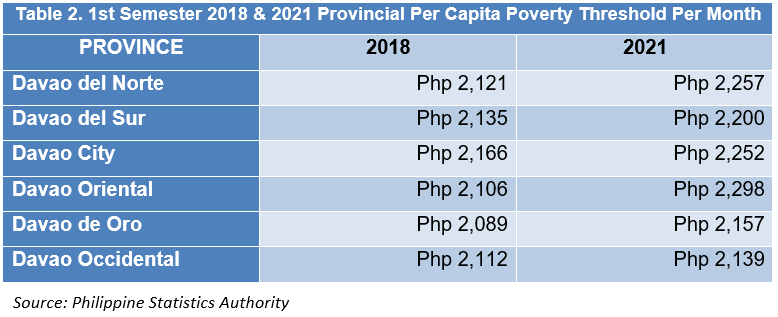
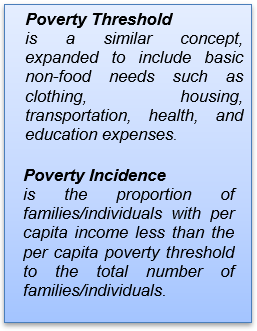
Among the provinces in Davao Region, Davao Oriental had the highest monthly per capita income requirement in the first semester 2021 at Php 2,298, up by 9.1 percent compared from the same period in 2018 at Php 2,106. On the other hand, Davao Occidental had the lowest monthly per capita poverty threshold at Php 2,139, which increased by 1.3 percent compared to 2018’s level of Php 2,112 (see Table 2).
1,040 thousand Davaoeños lived below poverty line
The first semester 2021 poverty incidence among population, or the proportion of poor Davaoeños whose per capita income is not sufficient to meet their basic food and non-food needs, was estimated at 19.4 percent. This translates to 1,040 thousand Davaoeños who lived below the poverty line.
The latest poverty incidence among Davao Region’s population is lower compared from the same period of 2018 at 23.8 percent. On the other hand, the national poverty incidence among population was posted at 23.7 percent.

By geographical location, the province of Davao Occidental posted the highest poverty incidence at 40.1 percent during the first semester 2021 which translates to a magnitude of 137.4 thousand poor persons. It was closely followed by Davao Oriental and Davao de Oro which registered a poverty incidence at 32.7 percent (or equivalent to 199.0 thousand poor individuals) and 27.9 percent (or corresponds 218.1 thousand poor individuals), respectively. Meanwhile, the poverty incidence of Davao del Sur was at 18.1 percent, which translates to 128.0 thousand population who lived below the poverty threshold. Similarly, Davao del Norte’s poverty incidence was 17.9 percent which is equivalent to 190.5 thousand poor persons. On the other hand, Davao City, the highly urbanized city in the region, had the least poverty incidence at 8.9 percent which is equivalent to 166.7 thousand poor Davaoeños in the first semester of 2021 (refer to Figure 1).
Php 1,548 is required for an individual to sustain basic food needs
For the food threshold, in the first semester of 2021, a Davaoeño is required to have at least Php 1,548, an average monthly income to meet his/her basic food needs. For a family of five members in Davao Region, it requires at Php 7,741, on the average, to meet their family’s basic food needs in a month. This was an increase of 4.6 percent or Php 341 from same semester of 2018 which was estimated at Php 7,400.
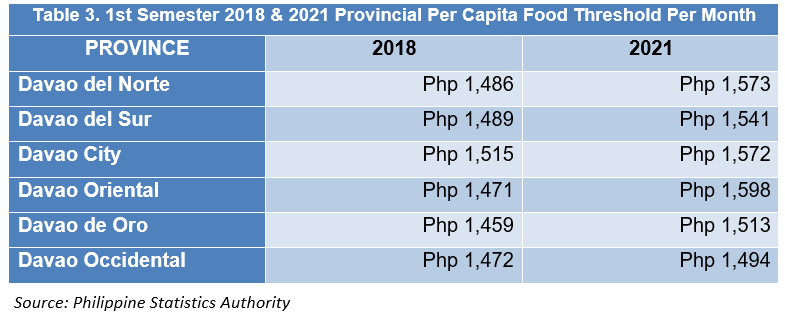
Among the provinces in Davao Region, Davao Oriental had the highest monthly per capita income food requirement in the first semester 2021 at Php 1,598, up by Php 127 compared from the same period in 2018 at Php 1,471. On the other hand, Davao Occidental had the lowest per capita food threshold at Php 1,494, monthly average, increased by Php 22 compared to 2018’s level of Php 1,472 (see Table 3).
47 out of 1,000 Davaoeño families are food poor families
The subsistence incidence among families in Davao Region was estimated at 4.7 percent in the first half of 2021. This means that 47 out of 1,000 Davaoeño families had incomes below the minimum amount needed to buy their basic food needs during this period. The latest subsistence incidence among families translates to 65 thousand families that fall below the food threshold in 2021, which was lower compared from the same period of 2018 at 84.2 thousand food poor families.
379 thousand Davaoeños has insufficient food income
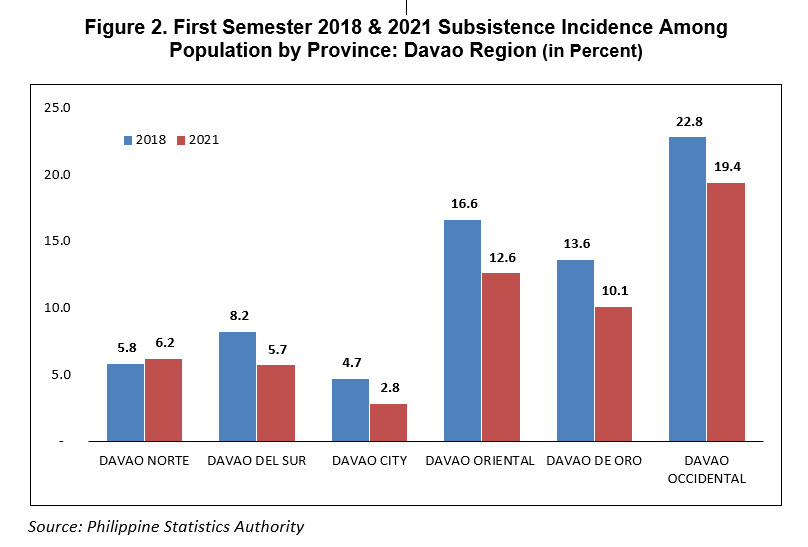

By geographical location, the province of Davao Occidental posted the highest subsistence incidence at 19.4 percent during the first semester 2021 which translates to a magnitude of 66.6 thousand food poor persons. It was followed by Davao Oriental and Davao de Oro which registered a subsistence incidence at 12.6 percent (or 76.4 thousand food poor individuals) and 10.1 percent (or 78.8 thousand food poor population). Meanwhile, the subsistence incidence of Davao del Norte registered at 6.2 percent, which translates to 65.5 thousand Davaoeños whose income is below the food threshold. Similarly, Davao del Sur’s subsistence incidence was 5.7 percent which is equivalent to 40.3 thousand food poor persons. On the other hand, Davao City, the Highly Urbanized City in the region, had the least subsistence incidence at 2.8 percent or around 51.6 thousand food poor Davaoeños in the first semester of 2021 (refer to Figure 2).
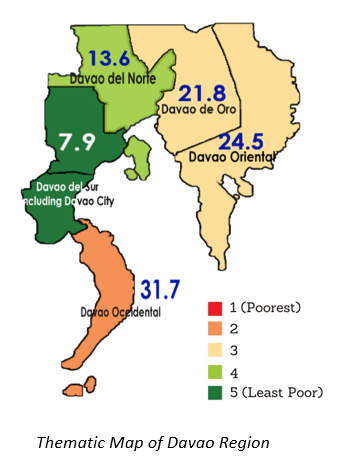
a) As common practice in most countries, the non-food component is measured indirectly due to the difficulty of determining the required bundle for the non-food items.
b) To ensure comparability across space and over time, the ratio of food expenditures (FE) to total basic expenditures (TBE) of a reference family (families whose per capita income is around the food threshold) is held constant for a certain period. The average of the nationally determined FE/TBE ratio from the FIES in 2000, 2003, 2006 and 2009, which is equivalent to 0.6983, has been used since 2009 and will still be used until 2021.
c) Sources of data:
• Family Income and Expenditure Survey, visit 1 conducted in July 2021. The total completed samples was 174,007 families spread across 117 sampling domains around the country. This large sample size can provide reliable estimates at the national level and disaggregation by regional, provincial and highly urbanized cities.

where:
Q = weighted total number of families (individuals) with semestral per capita income less than the semestral per capita poverty threshold/line
n = weighted total number of families (individuals)
Estimation of Food Threshold
a) The use of a national reference food bundle as starting point – to enhance comparability across space.
b) The national reference food bundle was converted to province-specific food bundles, which were used to estimate the provincial food thresholds. These provincial food bundles were formulated by nutritionists from the Food and Nutrition Research Institute and were subjected to the Test of Revealed Preferences such that the food bundle of a province will have the cheapest cost in comparison with the bundles of other provinces. The provincial food bundles have the following characteristics:
• Nutritionally adequate, i.e., it satisfies the 100% Recommended Energy and Nutrient Intakes (RENI) for energy and protein and 80% RENI for other vitamins and minerals;
• Food items in the food bundle are locally available and eaten in the area (in the province);
• Least cost in the province; and
• Visualizable (i.e., can be cooked together and fit for human consumption).
c) Sources of data:
• Provincial food bundles developed by FNRI
• Retail price surveys for the actual prices of agricultural and non-agricultural commodities, by province from PSA
• Proportion of food bought and own-produced components from the Food Consumption Survey, FNRI
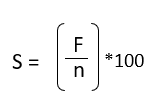
where:
F = weighted total number of families (individuals) with semestral per capita income less than the provincial urban-rural semestral per capita food threshold/line
n = weighted total number of families (individuals) in the province
APPROVED FOR RELEASED:
